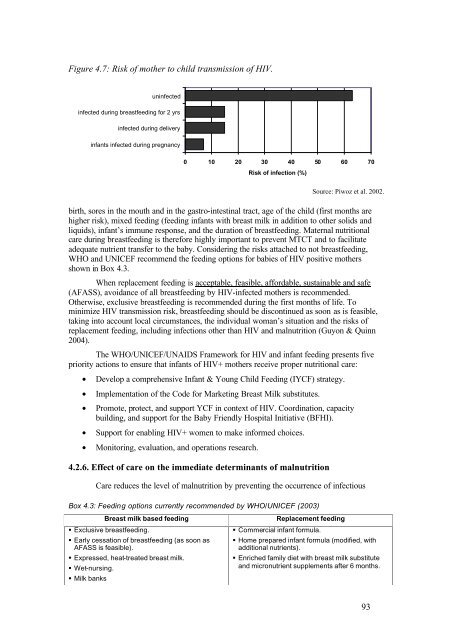An assessment of the causes of malnutrition in Ethiopia: A ...
An assessment of the causes of malnutrition in Ethiopia: A ...
An assessment of the causes of malnutrition in Ethiopia: A ...
You also want an ePaper? Increase the reach of your titles
YUMPU automatically turns print PDFs into web optimized ePapers that Google loves.
Figure 4.7: Risk <strong>of</strong> mo<strong>the</strong>r to child transmission <strong>of</strong> HIV.<br />
un<strong>in</strong>fected<br />
<strong>in</strong>fected dur<strong>in</strong>g breastfeed<strong>in</strong>g for 2 yrs<br />
<strong>in</strong>fected dur<strong>in</strong>g delivery<br />
<strong>in</strong>fants <strong>in</strong>fected dur<strong>in</strong>g pregnancy<br />
0 10 20 30 40 50 60 70<br />
Risk <strong>of</strong> <strong>in</strong>fection (%)<br />
Source: Piwoz et al. 2002.<br />
birth, sores <strong>in</strong> <strong>the</strong> mouth and <strong>in</strong> <strong>the</strong> gastro-<strong>in</strong>test<strong>in</strong>al tract, age <strong>of</strong> <strong>the</strong> child (first months are<br />
higher risk), mixed feed<strong>in</strong>g (feed<strong>in</strong>g <strong>in</strong>fants with breast milk <strong>in</strong> addition to o<strong>the</strong>r solids and<br />
liquids), <strong>in</strong>fant’s immune response, and <strong>the</strong> duration <strong>of</strong> breastfeed<strong>in</strong>g. Maternal nutritional<br />
care dur<strong>in</strong>g breastfeed<strong>in</strong>g is <strong>the</strong>refore highly important to prevent MTCT and to facilitate<br />
adequate nutrient transfer to <strong>the</strong> baby. Consider<strong>in</strong>g <strong>the</strong> risks attached to not breastfeed<strong>in</strong>g,<br />
WHO and UNICEF recommend <strong>the</strong> feed<strong>in</strong>g options for babies <strong>of</strong> HIV positive mo<strong>the</strong>rs<br />
shown <strong>in</strong> Box 4.3.<br />
When replacement feed<strong>in</strong>g is acceptable, feasible, affordable, susta<strong>in</strong>able and safe<br />
(AFASS), avoidance <strong>of</strong> all breastfeed<strong>in</strong>g by HIV-<strong>in</strong>fected mo<strong>the</strong>rs is recommended.<br />
O<strong>the</strong>rwise, exclusive breastfeed<strong>in</strong>g is recommended dur<strong>in</strong>g <strong>the</strong> first months <strong>of</strong> life. To<br />
m<strong>in</strong>imize HIV transmission risk, breastfeed<strong>in</strong>g should be discont<strong>in</strong>ued as soon as is feasible,<br />
tak<strong>in</strong>g <strong>in</strong>to account local circumstances, <strong>the</strong> <strong>in</strong>dividual woman’s situation and <strong>the</strong> risks <strong>of</strong><br />
replacement feed<strong>in</strong>g, <strong>in</strong>clud<strong>in</strong>g <strong>in</strong>fections o<strong>the</strong>r than HIV and <strong>malnutrition</strong> (Guyon & Qu<strong>in</strong>n<br />
2004).<br />
The WHO/UNICEF/UNAIDS Framework for HIV and <strong>in</strong>fant feed<strong>in</strong>g presents five<br />
priority actions to ensure that <strong>in</strong>fants <strong>of</strong> HIV+ mo<strong>the</strong>rs receive proper nutritional care:<br />
• Develop a comprehensive Infant & Young Child Feed<strong>in</strong>g (IYCF) strategy.<br />
• Implementation <strong>of</strong> <strong>the</strong> Code for Market<strong>in</strong>g Breast Milk substitutes.<br />
• Promote, protect, and support YCF <strong>in</strong> context <strong>of</strong> HIV. Coord<strong>in</strong>ation, capacity<br />
build<strong>in</strong>g, and support for <strong>the</strong> Baby Friendly Hospital Initiative (BFHI).<br />
• Support for enabl<strong>in</strong>g HIV+ women to make <strong>in</strong>formed choices.<br />
• Monitor<strong>in</strong>g, evaluation, and operations research.<br />
4.2.6. Effect <strong>of</strong> care on <strong>the</strong> immediate determ<strong>in</strong>ants <strong>of</strong> <strong>malnutrition</strong><br />
Care reduces <strong>the</strong> level <strong>of</strong> <strong>malnutrition</strong> by prevent<strong>in</strong>g <strong>the</strong> occurrence <strong>of</strong> <strong>in</strong>fectious<br />
Box 4.3: Feed<strong>in</strong>g options currently recommended by WHO/UNICEF (2003)<br />
Breast milk based feed<strong>in</strong>g<br />
• Exclusive breastfeed<strong>in</strong>g.<br />
• Early cessation <strong>of</strong> breastfeed<strong>in</strong>g (as soon as<br />
AFASS is feasible).<br />
• Expressed, heat-treated breast milk.<br />
• Wet-nurs<strong>in</strong>g.<br />
• Milk banks<br />
Replacement feed<strong>in</strong>g<br />
• Commercial <strong>in</strong>fant formula.<br />
• Home prepared <strong>in</strong>fant formula (modified, with<br />
additional nutrients).<br />
• Enriched family diet with breast milk substitute<br />
and micronutrient supplements after 6 months.<br />
93
















